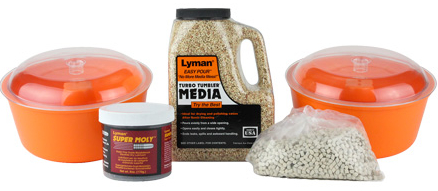All the rage in 1998 and all but dead 2018: here’s a look at some reasons why. KEEP READING
Glen Zediker
In a way, I guess nothing really happened to molybdenum-disulfide-coated bullets (“moly-coated”). They’re still for sale, as are means to make up your own. What I mean is why didn’t they attain the sustained popularity they started with about 20 years ago, back when many forecasted they would virtually replace bare bullets? Here’s my take, from my experience, on “what happened.”
I don’t know any shooter who tried them and wasn’t excited about results. I sho was!
Performance-wise, moly has a lot of benefits. A lot. The first and most: take two bullets, one coated and one bare, put the same load behind them, then shoot and chronograph. The coated bullet goes slower. How is that a help? The reason it goes slower is because moly drops chamber pressure (into and through the bore easier). And! That velocity loss (at least 50 fps, usually more) is not, proportionately, nearly as much as the accompanying drop in pressure (usually ballpark 4000+ psi). (These figures vary with the cartridge, but all show similar universal influence.) So. The moly-load can be increased beyond previous “maximum” velocity: the idea is to take the coated load up to normal chamber pressure. It works! It’s common to need at the least 1+ grain more propellant to level the coated load with the original bare-bullet load.
Other advantages: Most see improved velocity consistency, evidently resulting from the coating alone. The coated bullets seem to have no limit to the number of rounds that can be fired with no change in accuracy or impact location. Of course there is a limit, but I knew many going beyond 500 rounds between cleanings. And when I say “many,” I’m talking about serious competitive shooters. Another benefit is increased barrel life (less rapid throat erosion), and this is, I think, due to a faster-accelerating bullet getting into and through the throat more quickly (less intense flame). Moly bullets also release sooner from the case neck (additional “tension” is recommended).
I “switched.” (The motivation to write this came from a weekend shop-cleaning where I restacked a huge many boxes of coated bullets, and wondered if I’d ever shoot them…)
I got more bullet speed and zero loss of zero: big benefits to an NRA High Power Service Rifle shooter. 88 rounds per day, and 80gr bullets through a 20-inch barrel trying their best to get to 600 yards in close proximity of one another.

What is bad, then, about moly-coated bullets? Moly itself! It coats the bore with a layer of residue. This layer traps moisture and will, not can, corrode the steel underneath it. More: molybdenum disulfide outgases (outgas is the release of an occluded gas vapor that was part of the compound; a state change, pretty much) at lower than firing temperatures. That creates a chemical that, when mixed with water (including post-firing condensation), becomes, pretty much, sulfuric acid. That meant that the whole “zillion rounds between cleanings” didn’t really work. I know many who “lost” barrels, expensive barrels.
If the barrel is cleaned (correctly) after each use, no problems. But then another advantage is lost because starting with a clean barrel it takes quite a few rounds to return to zero. The layer has to be recreated.
The residue is x-difficult to remove. It doesn’t respond to routine means for bore maintenance, mostly meaning brush-and-solvent. The only way I found to get it gone was using micro-penetrating oil in conjunction with an abrasive paste-type cleaner, such as USP Bore Paste or JB Bore Compound.

I no longer use coated bullets. There are other coatings that have fewer disadvantages, like boron-nitride (doesn’t outgas), and some of the proprietary baked-on coatings a few major makers (like Barnes and Winchester) use don’t exhibit the post-firing issues “conventional” moly-coating creates (which usually was moly powder, followed by wax, which added to the tenacity of the residue).
However, another issue is that accuracy tends to suffer running bare bullets though a residue-coated bore (which results after only a few coated rounds, that are coated with anything). All that means, in short, is that running coated bullets is something that really has to be bought into. It’s a commitment, as I see it, and, as with many such things, pushing the limits on performance requires more attention to detail, more effort. It’s a matter of value.

Weigh the pros and cons. I honestly cannot, and will not, tell anyone not to use them. Coating can provide a serious performance increase. I don’t use moly-coat anymore, but that’s because my shooting needs are not so “serious” as they once were. I, yes, have gotten a tad amount lazy. I want to go to the range and enjoy my rifles and not lose sleep over the possibility of creeping corrosion if I didn’t clean up. I also want to be able to shoot different loads, including factory ammo, and maintain accuracy.
Last words: IF you choose moly, take steps to protect the barrel bore against the potential for damage. At the least, run some petroleum-based oil through the bore after shooting if you can’t clean it soon.
Tell about your experiences with moly.
See what Midsouth offers HERE
This article is adapted from Glen’s books, Handloading For Competition and Top-Grade Ammo, available at Midsouth HERE. For more information about other books by Glen, visit ZedikerPublishing.com









